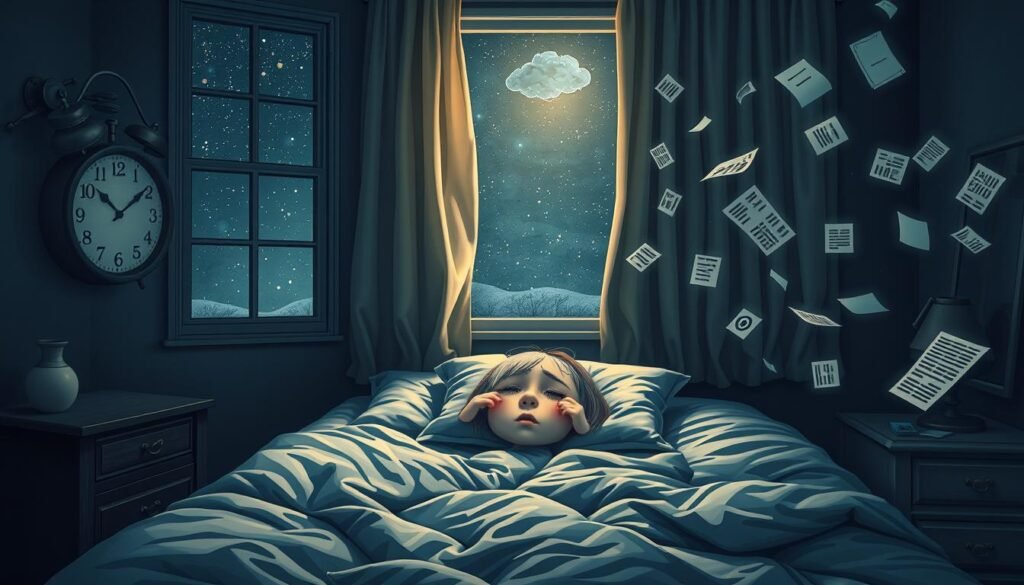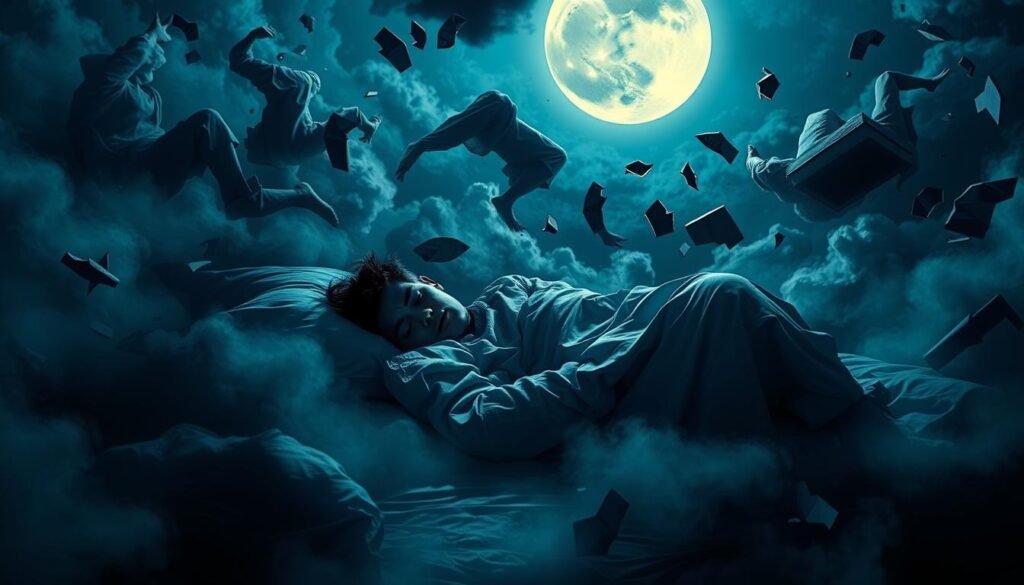About 1 in 5 Americans find it hard to stay asleep at night. This issue, known as sleep maintenance insomnia, makes them wake up often. It also makes it hard to fall asleep again, causing tiring days. Women and those assigned female at birth face more challenges. This is due to events like perimenopause, which bring disturbances like hot flashes.
It’s important to know the causes and symptoms of this insomnia. Also, knowing how to treat it can help those affected sleep better. This article aims to provide deep insights into sleep maintenance insomnia. It guides on improving sleep quality for a better life.
Key Takeaways
- 1 in 5 people suffer from sleep maintenance insomnia.
- Women and those assigned female at birth are more likely to experience insomnia.
- Mini-awakenings can happen up to 20 times per hour, though most people have two to three noticeable wake-ups.
- Enroll in web-based CBT-i programs, as 3 in 4 participants see significant symptom improvements.
- In-person CBT-i sessions can lead to better slumber after just a few weeks.
Understanding Sleep Maintenance Insomnia
Sleep maintenance insomnia involves waking up at night and not being able to fall back asleep. It affects your rest and well-being. This type is different from trouble falling asleep or waking up too early. Those with this condition have broken sleep, which hurts both how much and how well they sleep.
Definition and Comparison with Other Insomnia Types
This insomnia type is unique compared to others. Short-term insomnia is brief, often due to stress, and goes away quickly. Chronic insomnia lasts longer and may be tied to health problems. Knowing the type of insomnia is key for proper treatment. For more details on insomnia, check out this resource.
Common Symptoms of Sleep Maintenance Insomnia
Those with sleep maintenance insomnia face many challenges. They often wake up during the night. It can take them 20 to 30 minutes to fall asleep again. This leads to feeling tired and sleepy during the day.
They may also feel anxious about sleep, have trouble focusing, and suffer from headaches and mood swings. Tackling these issues involves understanding their causes and exploring treatments. Strategies like a calming bedtime routine and seeking advice can help improve sleep and well-being.
Causes of Sleep Maintenance Insomnia
Understanding sleep maintenance insomnia’s causes is key. Psychological and physical health problems are major factors. Exploring these can help find solutions.
Psychological Factors Contributing to Disruption
Psychological reasons are crucial in understanding insomnia. Stress and anxiety lead to more wake-ups at night. Worry and emotional distress make relaxing hard, so falling back asleep becomes a struggle. Depression also affects sleep quality, creating a negative cycle with mental health.
Physical Health Issues Related to Sleep Maintenance Insomnia
Physical health also complicates sleep maintenance insomnia. Chronic pain from conditions like arthritis or migraines disturbs sleep. Sleep apnea can cause breathing issues that wake you up often. Restless leg syndrome makes it hard to stay asleep. These issues show why medical checks are vital for solving sleep problems.

| Type of Factor | Examples |
|---|---|
| Psychological Factors | Stress, Anxiety, Depression |
| Physical Health Issues | Chronic Pain, Sleep Apnea, Restless Leg Syndrome |
The Role of Circadian Rhythms and Sleep Drive
Circadian rhythms play a big role in our sleep and wakefulness. These rhythms help us understand why sometimes we can’t stay asleep. Both circadian rhythms and our sleep drive are crucial for getting good sleep.
How Circadian Rhythms Influence Sleep Patterns
Our bodies have an internal clock tied to circadian rhythms. This clock controls when we sleep and wake up. If we sleep at odd times or use too much artificial light, it messes up these rhythms. This can make it hard to fall or stay asleep. For example, working night shifts or traveling often can upset our internal clock.
The Impact of Sleep Drive on Sleep Maintenance Insomnia
Sleep drive is like a timer that tells us when to sleep. It builds up the longer we are awake. By bedtime, it’s at its highest. But if we wake up in the night, this drive weakens. This makes it tough to go back to sleep. Knowing how sleep drive and circadian rhythms work together helps us fix sleep problems.

Impact of Sleep Disorders on Sleep Maintenance Insomnia
A variety of sleep disorders significantly influence sleep maintenance insomnia. Knowing how these disorders interact assists in effectively diagnosing and managing symptoms.
Connection to Sleep Apnea
Sleep apnea is a severe condition marked by breathing stops during sleep. It causes people to wake up often, struggling to stay asleep all night. This disorder is linked with a high chance of sleep maintenance insomnia.
The interruptions in sleep disturb rest quality, causing extreme tiredness during the day.
Role of Restless Leg Syndrome
Restless leg syndrome also affects sleep maintenance insomnia a lot. It makes people feel they must move their legs, causing discomfort, especially at rest or at night. This leads to frequent sleep interruptions, adding to insomnia symptoms.
It’s crucial to diagnose both conditions well for better sleep and overall health.
To understand insomnia better, including needed exams, exploring sleep evaluations can help a lot.

| Condition | Symptoms | Impact on Sleep |
|---|---|---|
| Sleep Apnea | Frequent awakenings, loud snoring | Causes disrupted sleep cycles |
| Restless Leg Syndrome | Uncomfortable leg sensations, urge to move | Leads to difficulty maintaining sleep |
| Chronic Insomnia | Difficulty falling/staying asleep, tiredness | Amplifies overall sleep fragmentation |
Looking at these connections helps create better treatment plans. These aim to enhance sleep health.
Tips to Improve Sleep Hygiene
It’s key for those with sleep troubles to improve their sleep hygiene. By adopting useful habits, one can boost both sleep quality and overall health.
Establishing a Relaxing Bedtime Routine
Having a regular bedtime routine readies you for better sleep. Activities like changing into pajamas, reading, or relaxation exercises tell your body it’s time to rest. Spending around 30 minutes on these activities before bed helps ease the transition into sleep.
Avoiding bright lights and screens is crucial for healthy sleep. This helps increase melatonin, making it easier to fall asleep.
Creating a Comfortable Sleep Environment
Making your sleeping area cozy is crucial for undisturbed sleep. This means having a good mattress and pillow, soft bedding, and the right room temperature. A dark, quiet bedroom reduces sleep interruptions. Adding a calming scent like lavender can make the space even more restful. Aim to make your bedroom as welcoming and peaceful as possible.
Limiting Stimulants and Distractions
Cutting down on stimulants and distractions is vital for good sleep hygiene. Drink less caffeine and alcohol before bed to sleep better. Avoid heavy meals and intense exercise in the evening. Instead, engage in calming activities to wind down. Taking brief, early afternoon naps boosts energy without harming night sleep. This keeps you sharp all day.
Cognitive Behavioral Therapy for Insomnia (CBT-i)
CBT-i helps those with sleep problems. It focuses on changing sleep thoughts and actions. This can lead to better sleep habits and quality. Most people will attend six to eight CBT-i sessions. But, the number can change based on what someone needs.
What is CBT-i and How Does it Work?
CBT-i is a top choice for treating insomnia, especially when it’s chronic. About 6-10% of people have chronic insomnia. The therapy uses several strategies including:
- Sleep Restriction Therapy (SRT): This increases sleep drive and efficiency.
- Stimulus Control Therapy (SCT): This helps make the bed a cue for sleep only.
- Cognitive Therapy (CT): This changes negative thoughts about sleep.
- Sleep Hygiene (SH): This is about having better sleep habits.
Qualified therapists can help a lot. Many studies show that 70% to 80% of those treated sleep better. They fall asleep faster, stay asleep longer, and wake up less at night.
Benefits of CBT-i for Sleep Maintenance Insomnia
CBT-i helps with more than just insomnia symptoms. It tackles the reasons behind poor sleep too. Unlike sleeping pills, CBT-i aims for lasting improvements in sleep habits. It’s also flexible, being available in group, one-on-one, or online formats.
Digital CBT-i makes this therapy reachable for more people. While mostly in English, and not for everyone, it’s still a big help. When combined with traditional methods, digital options can make treatment even better. This widens the therapy’s impact, helping more communities.
Role of Sleep Medication in Managing Insomnia
For many, sleep medication is key for dealing with sleep maintenance insomnia. These medicines offer short-term relief. It’s vital to know the types and risks of sleep meds. This knowledge lets people choose wisely for their sleep health.
Types of Sleep Medications
Various sleep meds offer unique benefits and downsides:
- Benzodiazepines (BZDs): Prescribed sedatives like diazepam and lorazepam help reduce the time it takes to fall asleep and increase sleep time. However, they also pose risks of dependence and negative side effects.
- Z-drugs: This group, including zolpidem and eszopiclone, improves sleep with generally fewer side effects than BZDs.
- Ramelteon: A safer option that targets melatonin receptors to assist with insomnia, with minimal adverse effects.
- Low-dose doxepin: As an antidepressant, it has benefits for sleep and is usually well-tolerated.
Potential Risks and Side Effects
Sleep meds come with risks. They may cause:
- Dependence, especially with benzodiazepines and some Z-drugs.
- Daytime sleepiness, which can disrupt daily activities.
- Euphoria or sedation the next day, affecting coordination and thinking.
- Withdrawal symptoms upon stopping some meds.
Before starting sleep medication, talk to a doctor. They can help assess the risks and find the best option for you.
Long-term Implications of Sleep Maintenance Insomnia
Chronic insomnia can seriously affect your body and mind. Those who can’t stay asleep might end up with health issues like hypertension. A study found that 34.7% of people with insomnia have hypertension. This is much higher compared to the 28% in the general population. These numbers show how insomnia can affect our health in the long run.
Effects on Physical Health and Wellness
Insomnia doesn’t just raise your blood pressure; it can also lead to more serious issues. These include heart disease, obesity, and weaker immune systems. Another study showed a 5.4% rise in hypertension cases after one year. This shows that not sleeping well can make your health worse over time. People with sleep issues report almost 14 days each year where their health stops them from doing daily activities. This is three times more than those without sleep problems.
Impact on Mental Health and Daily Functioning
Insomnia also hits hard on mental health, making anxiety and depression worse. Lack of sleep lowers mental health, sparking a harmful cycle. This affects how well someone can work, increases accidents, and lowers life quality.
Fighting insomnia can make both physical and mental health better. Techniques like Cognitive Behavioral Therapy and good sleep habits are key. The need for help is urgent, especially with data showing that insomnia leads to more doctor visits and trouble with day-to-day tasks. To learn more, check out this important study.
Conclusion
Tackling sleep maintenance insomnia requires a full plan. It looks at many factors and how to solve them. People with this issue often wake up a lot at night. This leads to feeling very tired during the day, having trouble focusing, and not feeling rested even after sleeping enough. This summary highlights the need to pinpoint specific causes, like chronic pain, anxiety, and certain lifestyle habits, that could make things worse.
To beat insomnia, improving sleep habits is key. This includes routines that help you relax and making your sleeping area better for sleep. Cognitive behavioral therapy for insomnia is one effective method, with great results in reducing symptoms of sleep problems. Adding exercise, relaxation techniques like yoga and meditation, and changing what you eat can also help a lot.
Realizing how crucial good sleep is for your body and mind matters a lot. By making holistic changes in life, getting help from professionals if needed, and building strength, people can improve their sleep. This enhances their life quality. It helps lessen the effects of sleep maintenance insomnia on their day-to-day lives.